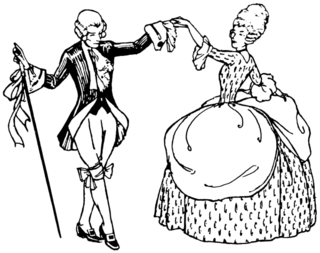In musical terminology, tempo, also known as beats per minute, is the speed or pace of a given composition. In classical music, tempo is typically indicated with an instruction at the start of a piece and is usually measured in beats per minute (BPM). In modern classical compositions, a "metronome mark" in beats per minute may supplement or replace the normal tempo marking, while in modern genres like electronic dance music, tempo will typically simply be stated in BPM.

A minuet is a social dance of French origin for two people, usually written in 3
4 time but always played as if in 6
8 to reflect the step pattern of the dance. The English word was adapted from the Italian minuetto and the French menuet.
Overture is a music instrumental introduction to a ballet, opera, or oratorio in the 17th century. During the early Romantic era, composers such as Beethoven and Mendelssohn composed overtures which were independent, self-existing, instrumental, programmatic works that foreshadowed genres such as the symphonic poem. These were "at first undoubtedly intended to be played at the head of a programme".

Atonality in its broadest sense is music that lacks a tonal center, or key. Atonality, in this sense, usually describes compositions written from about the early 20th-century to the present day, where a hierarchy of harmonies focusing on a single, central triad is not used, and the notes of the chromatic scale function independently of one another. More narrowly, the term atonality describes music that does not conform to the system of tonal hierarchies that characterized European classical music between the seventeenth and nineteenth centuries. "The repertory of atonal music is characterized by the occurrence of pitches in novel combinations, as well as by the occurrence of familiar pitch combinations in unfamiliar environments".

A nocturne is a musical composition that is inspired by, or evocative of, the night.

Alexander Nikolayevich Scriabin was a Russian composer and pianist. Before 1903, Scriabin was greatly influenced by the music of Frédéric Chopin and composed in a relatively tonal, late-Romantic idiom. Later, and independently of his influential contemporary Arnold Schoenberg, Scriabin developed a much more dissonant musical language that had transcended usual tonality but was not atonal, which accorded with his personal brand of metaphysics. Scriabin found significant appeal in the concept of Gesamtkunstwerk as well as synesthesia, and associated colours with the various harmonic tones of his scale, while his colour-coded circle of fifths was also inspired by theosophy. He is often considered the main Russian symbolist composer and a major representative of the Russian Silver Age.
Melisma is the singing of a single syllable of text while moving between several different notes in succession. Music sung in this style is referred to as melismatic, as opposed to syllabic, in which each syllable of text is matched to a single note. An informal term for melisma is a vocal run. The term roulade is also sometimes used interchangeably with melisma.
In music, the mystic chord or Prometheus chord is a six-note synthetic chord and its associated scale, or pitch collection; which loosely serves as the harmonic and melodic basis for some of the later pieces by Russian composer Alexander Scriabin. Scriabin, however, did not use the chord directly but rather derived material from its transpositions.
The clavier à lumières, or tastiera per luce, as it appears in the score, was a musical instrument invented by Alexander Scriabin for use in his work Prometheus: Poem of Fire. Only one version of this instrument was constructed, for the performance of Prometheus: Poem of Fire in New York City in 1915. The instrument was supposed to be a keyboard, with notes corresponding to colors as given by Scriabin's synesthetic system, specified in the score. However, numerous synesthesia researchers have cast doubt on the claim that Scriabin was a synesthete.
The Piano Sonata No. 9, Op. 68, commonly known as the Black Mass Sonata, is one of the late piano sonatas composed by Alexander Scriabin. The work was written around 1912–1913. Although its nickname was not invented by Scriabin, he approved of it.

The Piano Sonata No. 5, Op. 53, is a work written by Alexander Scriabin in 1907. This was his first sonata to be written in one movement, a format he retained from then on. A typical performance lasts from 11 to 12 minutes. The work is considered to be one of Scriabin's most difficult compositions, both technically and musically.

Karen Jill Elson is an English model and singer-songwriter.

Vladimir Vladimirovich Sofronitsky was a Soviet-Russian classical pianist, best known as an interpreter of Alexander Scriabin and Frédéric Chopin. His daughter is the Canadian pianist Viviana Sofronitsky.

Rebecca Anne Wood Elson was a Canadian–American astronomer and writer.

A roulade is a type of music ornamentation. The term has been used with some variation in meaning. While the term has had some usage in instrumental music, it is most frequently used in the context of vocal music to refer to a florid embellishment of several musical notes sung on a single syllable. The word has sometimes been used interchangeably with the term coloratura to refer to any difficult vocal run requiring great vocal dexterity, or as a synonym for or a specific type of virtuosic melisma. The term roulade has also been used more specifically to refer to the ornamental practice of splitting up the melodic line of a piece of music into many smaller notes.
Baritenor is a portmanteau (blend) of the words "baritone" and "tenor". It is used to describe both baritone and tenor voices. In Webster's Third New International Dictionary it is defined as "a baritone singing voice with virtually a tenor range". However, the term was defined in several late 19th century and early 20th century music dictionaries, such as The American History and Encyclopedia of Music, as "a low tenor voice, almost baritone [sic]."
Cornelia Calegari [Maria Cattarina ], was an Italian composer, singer, organist, and nun. She was revered for her singing talents in her home city and became a published composer in 1659, at the age of 15, with the release of her book of motets, Motetti à voce sola.

Leonid Leonidovich Sabaneyev or Sabaneyeff or Sabaneev was a Russian musicologist, music critic, composer and scientist. He was the son of Leonid Pavlovich Sabaneyev, a famous hunting expert, and his brother Boris was also a musician.

Arthur Eaglefield Hull was an English music critic, writer, composer and organist. He was the founder of the British Music Society.

Gilda Ruta was an Italian pianist, music educator and composer.










